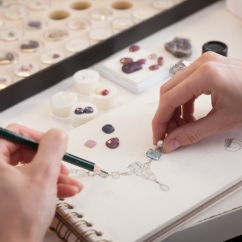Sales Strategy
Crafting a Career in Jewelry Design: A Guide for Aspiring Jewelers May 13, 2024 (0 comments)

Houston, TX--Jewelry combines artistic expression with technical skill, making a career in jewelry design both rewarding and lucrative. A guide published by Design Dash outlines the key information needed to turn your passion for jewelry into a professional pursuit.
[Image via blanaru/istock.com]
Jeweler vs. Gemologist: Understanding the Roles
It's crucial to differentiate between jewelers and gemologists. Jewelers design, create, and repair jewelry, requiring artistic flair and technical know-how. They often interact directly with clients to customize or restore jewelry.
Gemologists specialize in the scientific study of gemstones. They evaluate gemstones based on color and clarity, using specialized equipment to identify natural and synthetic stones and assess their quality.
Mastering the Craft: Techniques and Education
Essential Techniques and Tools
The guide states that beginning jewelers need a basic toolkit, including pliers, cutters, soldering equipment, and polishing tools. Fundamental techniques include casting, forging, and setting gemstones.
Advanced techniques like enameling and filigree offer opportunities to create intricate designs and require precision and patience.
Pathways to Becoming a Jeweler
According to the article, aspiring jewelers can choose from several educational routes. Formal education programs at art schools and universities cover both the artistic and technical sides of jewelry making. These programs typically include courses in design, metalworking, and stone setting.
Apprenticeships offer practical experience under experienced jewelers, providing a real-world context for learning traditional and modern techniques. Trade schools and technical programs focus on skill acquisition through shorter, intensive courses, which are ideal for those eager to enter the workforce quickly.
The article highlights the following courses offered by some institutions for aspiring jewelers:
- Gemological Institute of America (GIA): Offers hands-on training in jewelry fabrication and repair, alongside diplomas and certifications in design and gemology.
- LdM Institute: Provides a one-year certificate in Jewelry Design in Florence, Italy, covering classic and innovative techniques.
- Savannah College of Art and Design (SCAD): Features a comprehensive jewelry design program that includes advanced technique training and industry engagement.
- SUNY Buffalo State University: Offers a certificate in jewelry and metalsmithing that blends technical skills with aesthetic development.
- Baltimore Jewelry Center: Provides extensive training through a certificate program that covers everything from basic metal fabrication to advanced stone setting.
Choosing the right educational path and mastering the necessary skills are crucial for a successful career in jewelry design. By understanding the industry's roles and developing your artistic and technical abilities, you can create meaningful and beautiful jewelry.
Curious to learn more? Check out the entire guide published by Design Dash.






